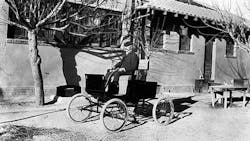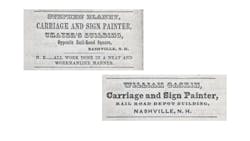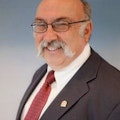Editor's Note: Welcome to YesterWreck – The Column, where each month we will examine the history of the collision repair industry through excerpts from a book researched and published by industry veteran, Gary Ledoux, called YesterWreck: The History of the Collision Repair Industry in America. Enjoy!
The Collision Repair Industry – Pre-1900
One would think that the place to start a story about collision repair would be with the first automobile accident. But long before there were cars, some of the companies that would later provide the means of repairing cars had their natal beginnings.
Timeline: 1792-1899
Way before the first automobiles hit the streets, many of the companies that serve the collision repair industry in the 21st century — and some of the earliest constructs of the industry — made their first appearance. And many of the people that brought us the innovations that make body repair possible today spent a childhood in the 19th century. In a time before automobiles, and during the automobiles’ early stages, little did they know what monumental contributions they would later make. So here, in chronological order, are many of the people, companies, products, and ideas that would later lead to the founding and support of the automobile collision repair industry of the 21st century.
1792 – Wiert Willemszoon Sikkens opens a small paint and varnish works in the Netherlands.
1800, January 1 – Escaping the French revolution and leaving their printing business behind, Pierre Samuel du Pont de Nemours and son Eleuthere Irenee (E.I.) DuPont arrive in America. They decide to enter into the business of manufacturing gunpowder. On April 27, 1802, for $6,740, the DuPonts purchase 65 acres of land in Wilmington, Delaware, and start manufacturing gunpowder. They call their product Brandywine Powder; their paint products would come later.
1806 – Valspar Refinish, makers of a variety of automotive refinish products, is founded.
1816 — The E.I. DuPont de Nemours Company of Wilmington, Delaware, becomes the single largest supplier of gunpowder in America.
1833 — Future explosives chemist, the man for whom the Nobel Peace Prize is named, and the man who shares his name with the Akzo conglomerate, Alfred Nobel is born.
1834 — Isaac Fisher patents the first process for mass-producing sandpaper.
1835, September 6 — The Ketjen Company is formed in the Netherlands to produce sulfuric acid. It will eventually be known as the KNZ company, and then the KZK company, and then KZO, which eventually became one of two conglomerates to form Akzo of Akzo Nobel.
1837 — Geert Willem Sikkens, son of Wiert Willemszoon Sikkens, continues the paint works founded by his father in 1792. In 1837, he enters into partnership with his cousin, Willem Penaat, to found the G.W. Sikkens & Company, a paint name still known in the 21st century.
1842, September 27 — Henry A. Sherwin, of Sherwin-Williams fame, is born. He is described in the company history as being “self-taught and self-propelled” and an “entrepreneur and inventor.” His formal education ended at 13, but he was ambitious.
1843, May 10 — Edward P. Williams, also of Sherwin-Williams fame, is born in Cleveland, Ohio. He attended Cleveland High School, graduating in 1859, and then went on to earn degrees at Hudson College. In 1870, he invested $15,000 of his own money and joined his friend Henry Sherwin in founding the Sherwin-Williams Company. His claim to fame within the company was organizing a formidable sales force.
1850 — Aetna Insurance Company is founded.
1866 — Henry A. Sherwin bought into and became a partner the Truman, Dunham and Company, purveyors of paint ingredients. He learned all he could about the paint business, endeavoring to “bring a fine sense of order” to it. But the partnership didn’t last long. By 1869, Sherwin discovered that his partners were more interested in producing linseed oil, while he was more interested in paint.
1868 — Nason Automotive Finishes is founded.
1870 Circa — American paint companies begin producing “sample color cards” – paint chips glued to cards so consumers could select the proper color paint for their home. This concept would later carry over to automotive paint.
1870, February 3 — The Sherwin-Williams Company is born. First-year sales are $422,000.
1875 — At a time when cowboys were driving herds of cattle to market, and the U.S. Army was fighting the Indian Wars across the plains, Alfred Dunk, the first “godfather” of the auto parts industry, was born. Were it not for Alfred Dunk and his vision for securing spare automobile parts in the 1930s, many a collision-damaged car would not have been repaired, and others would have been rendered useless.
1877, June 7 — George Jacob Mecherle is born. On his 45th birthday in 1922, Mecherle will found State Farm Insurance,
1878 — Martin Senour Automotive Finishes is founded.
1880 — Although no longer owned by the Sikkens family, the G.W. Sikkens & Company continues to make paint and varnishes primarily for the building trade but also expands to make lacquers for carriages and wagons.
1881 — Six chemical companies in Germany produce 50 percent of the world’s synthetic dyes used for making, among many other things, paint. One of these companies was future refinish paint giant BASF. By 1900, the six German companies control 90 percent of the world’s dyes. This would change with the start of World War I and have a profound effect on commercial color use in the U.S.
1882 — Spies-Hecker Inc. refinish products is founded.
1883 — PPG is founded as the Pittsburgh Plate Glass company.
1884 — Acme Automotive Finishes is founded.
1887 — Joseph Binks, a maintenance supervisor for Marshall Field’s department stores is charged with painting the store’s basement walls white – miles and miles of basement walls. Seeking a means of painting faster than a brush, he develops a spray apparatus with paint in a bucket pressurized by a hand pump. The paint is sprayed through a wand mechanism with a nozzle, not unlike a device to spray weed killer today. This method would be used to spray-paint the buildings at the 1893 Columbian Exposition. In 1919, Binks develops his first air-powered spray gun as we know them today.
1888 — Dr. Allen DeVilbiss creates an atomizer to spray medicine on his patient’s sore throats to help them heal faster. In 1907, his son, Thomas DeVilbiss, expands on the idea and creates the first hand-held, air-powered spray gun for paint. By blowing compressed air across the top of a siphon tube submerged in liquid, the gun could create a controllable pattern of material. The first spray guns are used primarily for furniture finishing.
1890 — H. Ledyard Towle is born in New York. During WWI, he rises to the rank of captain and become a camouflage expert and artist for the military. Later, he will become one of the leading “colorists” in the U.S. He, and others like him, showed the automotive industry that cars could be something other than “any color so long as it’s black.” Towle will lead the way through a color revolution in the automotive industry in the 1920s.
1895, June — While riding in a horse-drawn carriage, Dr. Carlos Booth of Youngstown, Ohio, experiences a runaway situation. To prevent that from happening again, he designs a motor vehicle and commissions a nearby shop to build it. Among its many features is a “body designed to hide the engine and the mechanisms of the vehicle.” (This is perhaps the earliest reference to an automobile body which served primarily as an aesthetic portion of the vehicle.) He is purportedly the first doctor in American to make house calls in a motor vehicle.
1895, November — Horseless Age magazine, the first automotive magazine, debuts. (Editor’s note: Motor Age, another magazine now published by FenderBender’s publisher, will have its first printing just four years later.)
1898, February 1 — Dr. Truman Martin of Buffalo, New York, buys the first automobile insurance policy from Traveler’s Insurance. It is unknown if he ever had to use it, or what his deductible might have been.
1899, July 19 — Mr. and Mrs. John D. Davis leave New York City driving a Duryea bound for Chicago. After many breakdowns and parts delays, they finally reach their destination four and a half months later. By today’s standards, it was a horrific trip. But in 1899, it marked the beginning of cross-country travel – something that would greatly contribute to the aggregate miles traveled in the U.S., and the overall accident rate and the number of cars requiring collision repair.
The First Traffic Accident
You can’t have a collision repair industry without a collision. But there are various versions of “the first accident,” and it seems historians can’t all agree on which one was… well; truly first. So, here are a few accounts of what may at least be “the earliest” accidents.
In 1899, the first car arrived in Arizona. It came by rail and was offloaded at Tucson. It was a Locomobile and licensed as vehicle Number One and went to a local physician, a Dr. Hiram Fenner. The first auto, the first license, and… the first time a car crashed into a saguaro cactus. It is unknown how the car, the cactus, or the good doctor fared. It is also unknown if Dr. Fenner made the first auto insurance claim in Arizona.
One early crash that many people like to cite is that of motorcyclist Sylvester Roper of Roxbury, Massachusetts. It seems Mr. Roper was an inventor and a pioneer and in 1896, developed his very own steam-powered motorcycle which he crashed, resulting in his demise. A newspaper account noted that Roper “Died in the Saddle.”
Also in 1896, on May 30 to be precise, while driving his Duryea Motor Wagon through Manhattan, Henry Wells hits a bicycle ridden by Evylyn Thomas, sending the woman flying. Fortunately, there were no fatalities, but Thomas spent the next few days in the hospital nursing a fractured leg. Wells spent the night in jail. It is unknown what happened to the bicycle or the Duryea Motor Wagon, but at that point it had to be clear to at least some that this type of incident would certainly not be the last.
Based on Mr. Wells’ experience, one might think that the Duryea Motor Wagon was under some spell of bad luck, because in February of 1893, J. Frank Duryea and Erwin F. Markham, builders of the Duryea Motor Wagon, are testing an early model inside the vacant second-floor of the Russell Machine Shop, in Springfield, Massachusetts, where the car had been built. Crude, even by the standards of the day, the “car” was little more than an engine and running gear placed on a carriage body. On its first run, the vehicle’s transmission fails to disengage, not allowing the vehicle to stop properly. Walking beside the slow-moving vehicle and seeing that a “crash was imminent,” Duryea frantically grabs the rear axle, slowing the speed so that when it reaches the opposite side of the room, the front wheels make only a slight bump against the wall. Although not on a public street, could this be said to be the first automobile accident? No damage is reported.
Several sources point to Ohio City, Ohio, for the first auto accident. From the turn of the 20th century forward, Detroit was known as the car-building capital of the U.S. and so had many firsts concerning the automobile. But prior to that time, Ohio was the “Michigan” of the era when it came to car-building, and thus, it had its share of firsts. In 1891, James Lambert and passenger James Swoveland hit a tree root while driving, causing the car to careen out of control and smash into a hitching post. How ironic is it that one of the world’s first cars hit a horse hitching post in one of the world’s first auto accidents? It is unknown if he was insured.
The earliest possible instance found goes all the way back to 1824. Inventor Samuel Morey (1762-1843) develop what he calls a “vapor engine,” an early version of the combustion engine. In Philadelphia, he demonstrates his engine by fastening it to a boat and a wagon. The engine attached to the wagon is started, the vehicle bucks, and Morey is thrown from the seat. The wagon lurches forward, propelling itself across the street and into a ditch, totaling the wagon. It’s quite possible this could be the very first motorized vehicle accident and the first total loss.
As I mentioned earlier, Horseless Age, the first automotive magazine, debuted in November 1895. The following excerpt is taken from its opening story, and is the perfect epilogue to this first installment of YesterWreck – The Column:
“All signs point to the motor vehicle as the necessary sequence of methods of locomotion already established and approved. The growing needs of our civilization demand it, the public believe in it and await with lively interest its practical application to the daily business of the world.”
Horseless Age magazine, Volume 1 Number 1
November 1895
Excerpted from Ledoux’s book, YesterWreck: The History of the Collision Repair Industry in America, available here.
About the Author
Gary Ledoux
A native of New Hampshire, Gary Ledoux retired in 2017 after a 48-year career in the automotive industry. For 18 years, he worked in various capacities in numerous car dealerships in New Hampshire. In 1988, Gary began his career with American Honda, eventually serving as the assistant national manager for American Honda’s Collision Parts Marketing Department, and was instrumental in launching Honda’s certified body shop program. He was very active in the collision repair industry, serving on various Collision Industry Conference (CIC) committees and as a three-time chairman of the OEM Collision Repair Roundtable. Today, Ledoux is a freelance writer splitting his time between his Florida home and vacation property in South Carolina. In the summer of 2018, he published his fifth book, YesterWreck: The History of the Collision Repair Industry in America.


